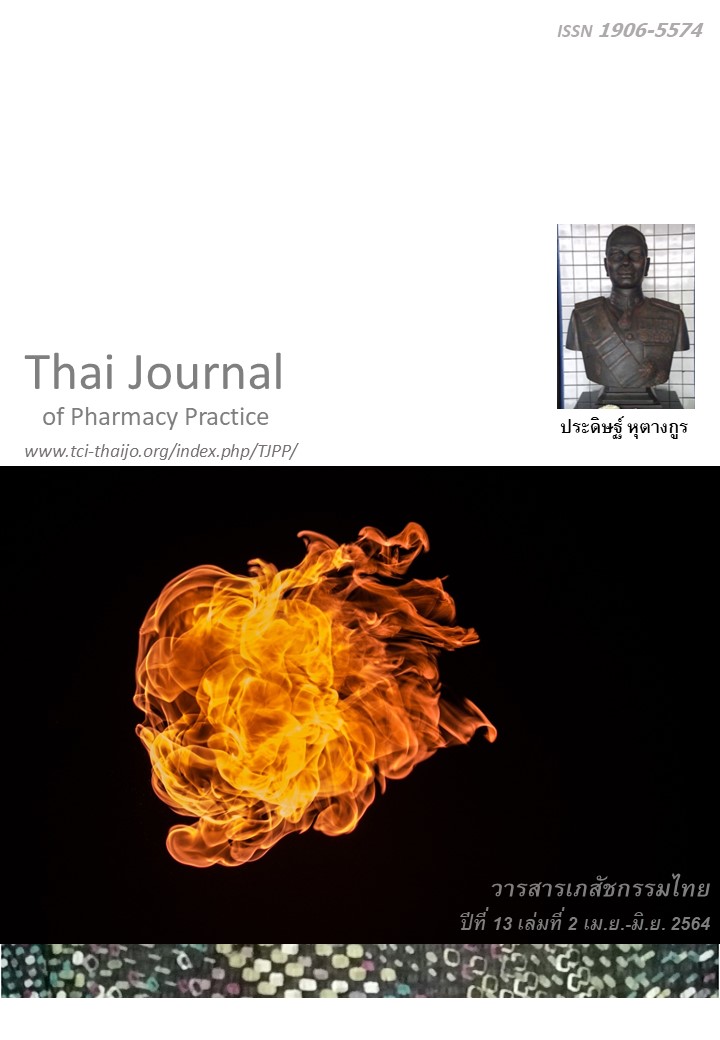ความชุกของภาวะพหุสัณฐานของยีน CASR rs1042636 ใน ผู้ป่วยชาวไทยที่ได้รับการฟอกเลือดด้วยเครื่องไตเทียม
Main Article Content
บทคัดย่อ
วัตถุประสงค์: เพื่อหาความชุกของจีโนไทป์และแอลลีลของภาวะพหุสัณฐานของยีน CASR rs1042636 ในผู้ป่วยชาวไทยที่ได้รับการฟอกเลือดด้วยเครื่องไตเทียม และเปรียบเทียบความถี่ของแอลลีลของยีนดังกล่าวที่พบในประชากรไทยกับประชากรเชื้อชาติอื่น วิธีการ: การวิจัยนี้เป็นการวิจัยเชิงสังเกตในผู้ป่วยที่ได้รับการฟอกเลือดด้วยเครื่องไตเทียม ณ โรงพยาบาลจุฬาลงกรณ์ ที่มีภาวะพาราไทรอยด์สูงชนิดทุติยภูมิและเริ่มได้รับยา cinacalcet ในเดือน ม.ค. 2558 - พ.ค. 2562 การตรวจหาภาวะพหุสัณฐานของยีน CASR rs1042636 ใช้วิธี TaqMan genotyping assay การศึกษาเปรียบเทียบความถี่ของแอลลีลของยีนของประชากรไทยในการศึกษาครั้งนี้และประชากรอื่นที่พบรายงาน ผลการวิจัย: ผู้ป่วยเข้าร่วมการศึกษา 126 ราย การศึกษาพบความชุกของจีโนไทป์แบบ AA, AG, และ GG ร้อยละ 23.0, 47.6 และ 29.4 ตามลำดับ และพบความถี่ของแอลลีล A ร้อยละ 46.8 และแอลลีล G ร้อยละ 53.2 ความชุกแอลลีลของยีน CASR rs1042636 ของประชากรไทยในการศึกษานี้ไม่แตกต่างจากความชุกที่พบรายงานในประชากรอื่นในเอเชียได้แก่ ญี่ปุ่น จีน และ เกาหลี (P=0.339, 0.901, 0.850 ตามลำดับ) แต่มีความแตกต่างจากประชากรเชื้อชาติคอเคเซียนและแอฟริกัน-อเมริกัน ความชุกของแอลลีล A ในประชากรไทยต่ำกว่าในชาวคอเคเซียนและแอฟริกัน-อเมริกันอย่างมีนัยสำคัญ (P<0.001) สรุป: ความชุกของภาวะพหุสัณฐานของยีน CASR rs1042636 ในผู้ป่วยชาวไทยที่ได้รับการฟอกเลือดด้วยเครื่องไตเทียมไม่แตกต่างจากประชากรชาวเอเชียอื่น ๆ แต่แตกต่างจากประชากรชาวผิวขาวและผิวดำอย่างมีนัยสำคัญทางสถิติ
Article Details
ผลการวิจัยและความคิดเห็นที่ปรากฏในบทความถือเป็นความคิดเห็นและอยู่ในความรับผิดชอบของผู้นิพนธ์ มิใช่ความเห็นหรือความรับผิดชอบของกองบรรณาธิการ หรือคณะเภสัชศาสตร์ มหาวิทยาลัยสงขลานครินทร์ ทั้งนี้ไม่รวมความผิดพลาดอันเกิดจากการพิมพ์ บทความที่ได้รับการเผยแพร่โดยวารสารเภสัชกรรมไทยถือเป็นสิทธิ์ของวารสารฯ
เอกสารอ้างอิง
Rodriguez M, Nemeth E, Martin D. The calcium-sensing receptor: a key factor in the pathogenesis of secondary hyperparathyroidism. Am J Physiol Renal Physiol 2005; 288: F253-64.
Brown EM. Physiology and pathophysiology of the extracellular calcium-sensing receptor. Am J Med 1999;106: 238-53.
Tfelt-Hansen J, Brown EM. The calcium-sensing receptor in normal physiology and pathophysiology: a review. Crit Rev Clin Lab Sci 2005; 42: 35-70.
Riccardi D, Brown EM. Physiology and pathophysio logy of the calcium-sensing receptor in the kidney. Am J Physiol Renal Physiol 2010; 298: F485-99.
Chattopadhyay N, Mithal A, Brown EM. The calcium-sensing receptor: a window into the physiology and pathophysiology of mineral ion metabolism. Endocr Rev 1996; 17: 289-307.
Thakker R. Calcium-sensing receptor: Role in health and disease. Indian J Endocrinol Metab 2012; 16 (Suppl 2): S213-6.
Vahe C, Benomar K, Espiard S, Coppin L, Jannin A, Odou M, et al. Diseases associated with calcium-sensing receptor. Orphanet J Rare Dis 2017; 12: 19-27.
Conigrave AD. The calcium-sensing receptor and the parathyroid: past, present, future. Front Physiol 2016; 7: 563-75
Eknoyan G, Levin A, Levin NW. Bone metabolism and disease in chronic kidney disease. Am J Kidney Dis 2003; 42: 1-201.
Fraser WD. Hyperparathyroidism. Lancet 2009; 374: 145-58.
Sutheechai S, Sudchada P. Mineral and bone disorder in chronic kidney disease. Srinagarind Medical Journal 2012; 27: 415-23.
Yano S, Sugimoto T, Kanzawa M, Tsukamoto T, Hattori T, Hattori S, et al. Association of polymorphic alleles of the calcium-sensing receptor gene with parathyroid hormone secretion in hemodialysis patients. Nephron 2000; 85: 317-23.
Yamauchi M, Sugimoto T, Yamaguchi T, Yano S, Kanzawa M, Kobayashi A, et al. Association of polymorphic alleles of the calcium-sensing receptor gene with the clinical severity of primary hyperparathyroidism. Clin Endocrinol (Oxf) 2001; 55: 373-9.
Rohlfs RV, Weir BS. Distributions of Hardy–Weinberg equilibrium test statistics. Genetics 2008; 180: 609-16.
Corbetta S, Eller-Vainicher C, Filopanti M, Saeli P, Vezzoli G, Arcidiacono T, et al. R990G polymorphism of the calcium-sensing receptor and renal calcium excretion in patients with primary hyperparathyroidism. Eur J Endocrinol 2006; 155: 687-92.
Schwartz GG, John EM, Rowland G, Ingles SA. Prostate cancer in African-American men and polymorphism in the calcium-sensing receptor. Cancer Biol Ther 2010; 9: 994-9.
Han G, Wang O, Nie M, Zhu Y, Meng X, Hu Y, et al. Clinical phenotypes of Chinese primary hyperparathyroidism patients are associated with the calcium-sensing receptor gene R990G polymorphism. Eur J Endocrinol 2013; 169: 629-38.
Jeong S, Kim I-W, Oh K-H, Han N, Joo KW, Kim HJ, et al. Pharmacogenetic analysis of cinacalcet response in secondary hyperparathyroidism patients. Drug Des Devel Ther 2016; 10: 2211-25.
Cole DE, Peltekova VD, Rubin LA, Hawker GA, Vieth R, Liew C, et al. A986S polymorphism of the calcium-sensing receptor and circulating calcium concentrations. Lancet 1999; 353: 112-5.
Vezzoli G, Terranegra A, Arcidiacono T, Biasion R, Coviello D, Syren M, et al. R990G polymorphism of calcium-sensing receptor does produce a gain-of-function and predispose to primary hypercalciuria. Kidney Int 2007; 71: 1155-62.
Eren P, Turan K, Berber I, Canbakan M, Kara M, Tellioglu G, et al. The clinical significance of parathyroid tissue calcium sensing receptor gene polymorphisms and expression levels in end-stage renal disease patients. Clin Nephrol 2009; 72: 114-21


